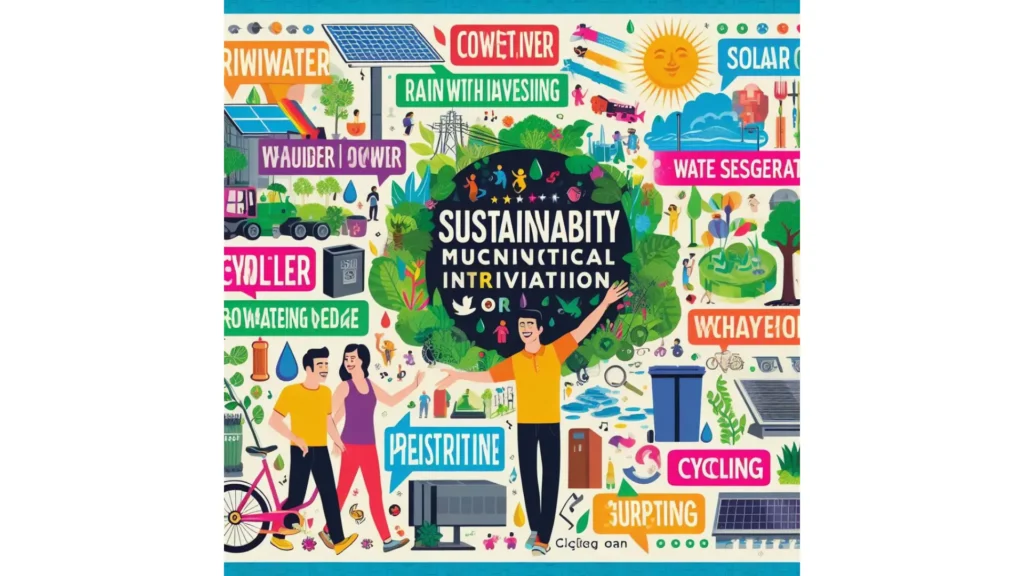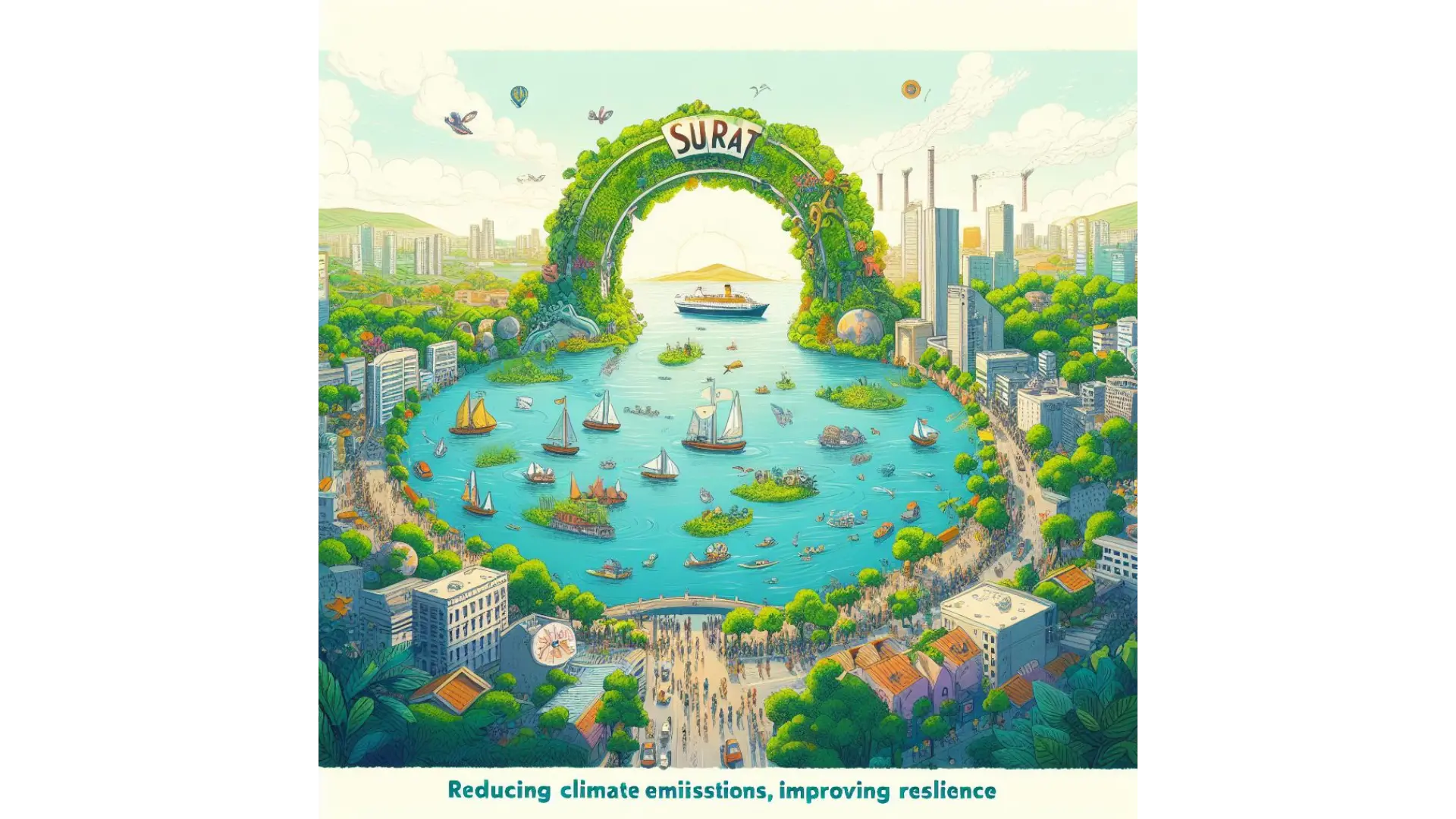What Does Surat Do for Maintaining A Sustainable Environment
Surat’s Sustainability Initiatives
Surat, a city in India, is renowned for its textile industry. However, it has recently emerged as a frontrunner in sustainable urban development. The question of ‘What Does Surat Do for Maintaining A Sustainable Environment?, can be answered by looking at the city’s several initiatives launched to minimize its environmental footprint and enhance the living conditions of its inhabitants.
One of Surat’s most significant sustainability accomplishments is its wastewater treatment system. It is the only city in India that treats all of its wastewater, thereby safeguarding the city’s water resources and reducing pollution.

The city has also made substantial investments in renewable energy. Solar panels have been installed on public buildings, and efforts are underway to encourage residents and businesses to adopt solar energy. Currently, 34% of Surat’s energy comes from renewable sources.
In addition to wastewater treatment and renewable energy, Surat is also striving to improve its air quality. The city has introduced several measures to curb air pollution from vehicles and industry, including stricter vehicle emission standards and the promotion of public transportation.
Surat is also dedicated to increasing its green cover. In recent years, the city has planted millions of trees and is working on creating new parks and green spaces. At present, Surat has 18% green cover, with a goal to increase this to 25% by 2025.
Here are some specific examples of Surat’s sustainability initiatives:
Wastewater Treatment
Surat’s wastewater treatment system is among the most advanced in India. It employs a mix of biological and physical processes to treat wastewater before it is released into the environment, thereby protecting the city’s water resources, and reducing pollution.
Renewable Energy
Surat has made significant investments in renewable energy. The city has installed solar panels on public buildings and is promoting solar energy adoption among residents and businesses. Currently, 34% of Surat’s energy comes from renewable sources.
Air Quality
Surat is implementing several measures to improve air quality, including stricter vehicle emission standards and promoting public transportation. The city has also planted millions of trees in recent years to help improve air quality.
Green Cover
Surat is dedicated to increasing its green cover. The city has planted millions of trees in recent years and is working on creating new parks and green spaces. Currently, Surat has 18% green cover, with a goal to increase this to 25% by 2025.
Surat’s sustainability initiatives are positively impacting the environment and improving the quality of life for its residents. The city serves as a model for other cities in India and around the world that are seeking to reduce their environmental impact and become more sustainable.
Surat’s Wastewater Treatment System
Surat’s wastewater treatment system is among the most sophisticated in India. It employs a blend of biological and physical processes to purify wastewater prior to its release into the environment, thereby safeguarding the city’s water resources and mitigating pollution. The system involves several stages, beginning with the screening of wastewater to eliminate large objects like plastics and wood.
Following this, chemicals are used to extract sand and other solids. The wastewater is then subjected to bacterial treatment to decompose organic matter. Lastly, the wastewater undergoes disinfection to eradicate any remaining harmful bacteria. This system is capable of eliminating up to 90% of pollutants from the wastewater, thereby protecting the city’s water resources and reducing pollution.

Advantages of Surat’s Wastewater Treatment System
The wastewater treatment system offers numerous benefits such as:
Water Resource Protection
The system aids in preserving the city’s water resources by eliminating pollutants from the wastewater before it is released into the environment. This enhances water quality and renders it safer for human consumption.
Pollution Reduction
The system contributes to pollution reduction by removing pollutants from the wastewater prior to its release into the environment. This enhances air and water quality, making the city a healthier place to reside.
Surat’s Sustainability Journey: Initiatives, Challenges, Successes, and Goals
The Municipal Commissioner of Surat discussed the city’s trials, triumphs, and objectives in its journey towards a sustainable urban future.
Challenges Regarding What Does Surat Do for Maintaining A Sustainable Environment
The city has the following challenges:
Accelerated Expansion: Surat has witnessed a population surge of over 50% in the last decade, exerting pressure on its infrastructure and resources.
Air Quality: The city, being a hub for numerous textile mills and other industries, grapples with air pollution.
Successes
Wastewater Treatment: Surat stands out as the sole city in India that treats all of its wastewater, thereby safeguarding water resources and mitigating pollution.
Renewable Energy: Surat has made substantial investments in renewable energy, with renewable sources accounting for 34% of its energy.
Goals
- Minimize Air Pollution
- Expand Green Cover
- Encourage Public Transportation
- Enhance Energy Efficiency
The Municipal Commissioner expressed confidence in Surat’s ability to attain its sustainability objectives and serve as a benchmark for other cities in India and globally.
Surat’s Climate Change Plan: Reducing Emissions, Improving Resilience
The Surat Municipal Corporation (SMC) has initiated several measures to foster a sustainable Surat, including the formulation of a Climate Change Plan for the city.
The Climate Change Plan was devised in partnership with the National Institute of Urban Affairs (NIUA) and the Asian Cities Climate Change Resilience Network (ACCCRN). The plan pinpoints the city’s primary susceptibilities to climate change and proposes a range of adaptation and mitigation strategies.
The Climate Change Plan encompasses the following principal objectives:
- Minimize greenhouse gas emissions.
- Enhance the city’s resilience to climate change impacts
- Foster sustainable development
The plan incorporates a variety of specific strategies, such as:
- Advocating for renewable energy
- Boosting energy efficiency
- Decreasing waste generation
- Expanding green cover
- Improving drainage and flood control
- Fortifying early warning systems
The SMC is presently engaged in executing the Climate Change Plan. The plan is being rolled out in phases, with several projects already accomplished.
- For instance, the SMC has fitted solar panels on public buildings and is promoting solar energy adoption among residents and businesses. The SMC has also planted millions of trees in recent years to enhance air quality and mitigate the city’s susceptibility to heat waves.
- The SMC is also striving to enhance the city’s drainage and flood control system. This is crucial as Surat, being a coastal city, is prone to flooding due to sea level rise and storm surges.
- The SMC is also fortifying the city’s early warning systems. This is vital as it will enable the city to evacuate people and implement other protective measures ahead of extreme weather events.
- The SMC’s Climate Change Plan is a comprehensive and ambitious blueprint for transforming Surat into a more sustainable and resilient city. The plan is being rolled out in phases, with several projects already accomplished. The SMC is dedicated to executing the plan and positioning Surat as a model for sustainable urban development.
Sustainability Indicators for Surat City: Measuring Progress, Tracking Change
The case study titled “Sustainability Indicators: A Case of Surat City” scrutinizes how Surat, a city in India, is employing sustainability indicators to gauge and monitor its advancement towards sustainable development.
The case study commences by offering an overview of sustainability indicators and their significance. Sustainability indicators are quantitative or qualitative metrics that can be utilized to evaluate the performance of a system or organization in terms of sustainable development. They can be employed to monitor progress over time, pinpoint areas requiring improvement, and make informed decisions regarding resource allocation.
The case study subsequently discusses the specific sustainability indicators that Surat is employing. These indicators are categorized into three groups: social, environmental, and economic.
Social indicators assess aspects of human well-being, such as access to education and healthcare, poverty rates, and crime rates. Environmental indicators evaluate the impact of human activity on the environment, such as air and water quality, greenhouse gas emissions, and biodiversity. Economic indicators gauge the economic performance of the city, such as GDP growth, employment rates, and inflation.
The case study reveals that Surat is making substantial progress towards sustainable development. The city has accomplished several notable feats, such as treating all of its wastewater and generating 34% of its energy from renewable sources.
However, the case study also highlights some areas where Surat needs to enhance its efforts. For instance, the city’s air quality remains a significant concern. The case study concludes by recommending several steps that Surat can undertake to further improve its sustainability performance.
The case study offers a valuable illustration of how sustainability indicators can be employed to gauge and monitor progress towards sustainable development. Surat’s experience is particularly pertinent to other developing cities that aspire to become more sustainable.
Surat City Resilience Strategy: Building a More Sustainable and Resilient Future
The Surat City Resilience Strategy is an all-encompassing plan aimed at enhancing the resilience of Surat, India. The strategy was formulated in partnership with a diverse array of stakeholders, encompassing the Surat Municipal Corporation, businesses, academia, and civil society.
The strategy pinpoints the principal challenges confronting Surat, including climate change, urbanization, and poverty. It then proposes a range of strategies to tackle these challenges and construct a more resilient city.
The strategy is segmented into four crucial areas:
Climate Resilience
The strategy incorporates several measures to bolster Surat’s resilience to climate change impacts such as flooding, heat waves, and drought. These measures encompass improving drainage and flood control systems, developing early warning systems, and advocating for sustainable land use practices.
Urban Resilience
The strategy also includes several measures to enhance Surat’s resilience to urban challenges like traffic congestion, air pollution, and inadequate housing. These measures involve investing in public transportation, developing green spaces, and improving waste management.
Social Resilience
The strategy acknowledges the significance of social resilience in constructing a more resilient city. Social resilience pertains to the capacity of a community to absorb, recover from, and prepare for shocks and stresses. The strategy incorporates several measures to foster social resilience such as improving education and healthcare services and promoting social cohesion.
Economic Resilience
The strategy also includes several measures to enhance Surat’s economic resilience. These measures involve promoting economic diversification, investing in infrastructure, and supporting small businesses.
The Surat City Resilience Strategy is a comprehensive and ambitious blueprint for transforming Surat into a more resilient city. The strategy is currently being executed by the Surat Municipal Corporation along with several other stakeholders.
The strategy is crucial as it provides a framework for Surat to tackle the challenges it confronts and construct a more sustainable and resilient future.
Analysis of Surat City’s Development Strategy towards Sustainable Smart City Infrastructure
The evaluation of Surat City’s Development Strategy towards Sustainable Smart City Infrastructure indicates that the city is making substantial strides towards evolving into a more sustainable and smarter city. The city has launched several initiatives to enhance its infrastructure, mitigate its environmental impact, and elevate the quality of life for its inhabitants.
Key findings from the analysis include:
- Surat has made substantial investments in renewable energy, with renewable sources now accounting for 34% of its energy.
- Surat stands out as the only city in India that treats all of its wastewater.
- Surat has planted millions of trees in recent years to enhance air quality and reduce its susceptibility to heat waves.
- Surat is investing in public transportation and developing green spaces to render the city more livable and sustainable.
- Surat is also striving to fortify its early warning systems and enhance its drainage and flood control system to increase the city’s resilience to climate change impacts.
The analysis also highlights some areas where Surat needs to improve. For instance, the city’s air quality remains a significant concern. The analysis suggests several steps that Surat can undertake to further enhance its sustainability performance, such as:
- Investing in additional renewable energy projects
- Promoting energy efficiency
- Reducing waste generation
- Expanding green cover
- Improving public transportation
Fortifying early warning systems and enhancing drainage and flood control system
The analysis reveals that Surat is making substantial progress towards evolving into a more sustainable and smarter city. The city has several initiatives in place that are enhancing its infrastructure, mitigating its environmental impact, and elevating the quality of life for its inhabitants. While there are still some areas where Surat needs to improve, the analysis is optimistic and suggests that the city is on the right path towards becoming a model for sustainable urban development.
Future Projects on Water Resources for Sustainable Urban Development in Surat City
The research titled “Future projects on water resources for a sustainable urban development: a case study of Surat city of India” scrutinizes the challenges and opportunities related to water resources in Surat, India, and suggests several future projects to tackle these challenges and ensure a sustainable water supply for the city.
The research commences by offering an overview of Surat’s water resources and the challenges it confronts. Surat, a rapidly expanding city with a population exceeding 5 million, is experiencing a swift increase in water demand while its water resources are limited. The city is also susceptible to climate change impacts such as droughts and floods, which could further intensify the city’s water-related challenges.
The research subsequently proposes several future projects that Surat could undertake to address its water challenges and ensure a sustainable water supply. These projects encompass:
Building new dams and reservoirs
Surat could construct new dams and reservoirs to augment its water storage capacity. This would assist the city in meeting its escalating water demand and enhance its resilience to droughts.
Desalination
Surat could invest in desalination plants to transform seawater into freshwater. This would help the city reduce its dependence on surface water resources and increase its resilience to droughts.
Rainwater harvesting
Surat could advocate for rainwater harvesting to collect and store rainwater for future use. This would help the city reduce its dependence on surface water resources and bolster its water security.
Water conservation
Surat could implement water conservation measures to decrease water consumption and enhance water efficiency. This would assist the city in meeting its escalating water demand with its limited water resources.
The research concludes by recommending that Surat adopt a comprehensive approach to water resource management that incorporates a blend of supply-side and demand-side measures. The research also suggests that Surat involve all stakeholders in the planning and implementation of its water resource projects.
The research offers a valuable evaluation of Surat’s water resource challenges and opportunities. The proposed future projects outlined in the research could assist Surat in addressing its water challenges and ensuring a sustainable water supply for the city.
Conclusion: Surat’s Sustainability Journey
Surat’s dedication to sustainability is reflected in its bold development plan, which envisions the city as a smart city with a sustainable infrastructure. The city also has several upcoming projects related to water resources, aimed at ensuring a sustainable water supply for its expanding population.
Surat is a city that is actively moving towards a greener future. Its sustainability initiatives are serving as a beacon for cities globally, and its achievements prove that economic growth and environmental conservation can coexist.
Here are some notable insights from Surat’s journey towards sustainability:
- Innovation is crucial. The city’s wastewater treatment system exemplifies how innovative solutions can address complex environmental challenges.
- Collaborations between the public and private sectors are vital. The success of Surat’s sustainability initiatives can be attributed to robust partnerships among the government, businesses, and civil society.
- The involvement of the community is paramount. The citizens of Surat have significantly contributed to the city’s sustainability journey by endorsing its initiatives and altering their behaviours.
- Tracking progress is necessary. The sustainability indicators of Surat have enabled the city to monitor its advancements and pinpoint areas that need enhancement.
Surat’s path towards sustainability serves as an exemplary model for cities worldwide. By fostering innovation, establishing partnerships, involving the community, and tracking progress, Surat is paving the way for a more sustainable and resilient future for its inhabitants.

